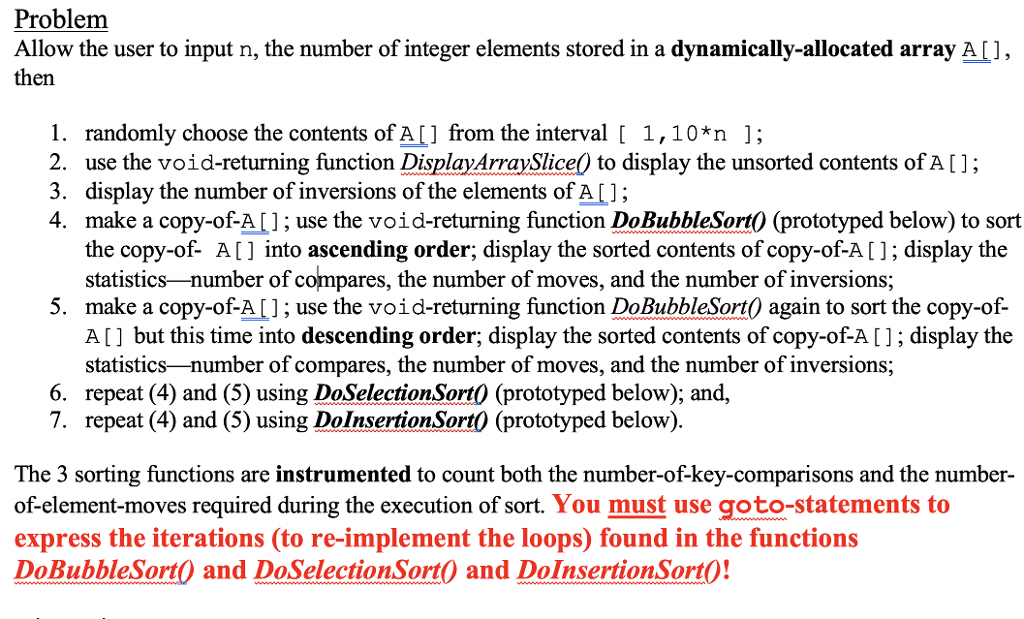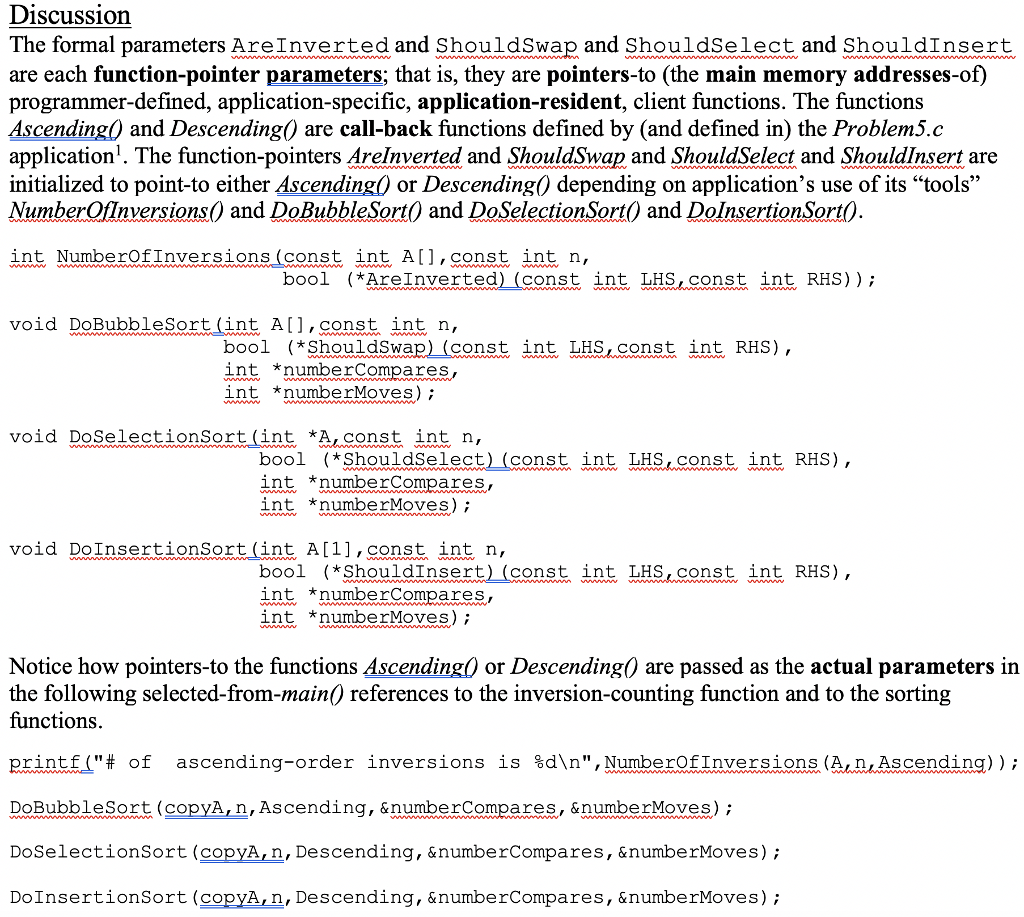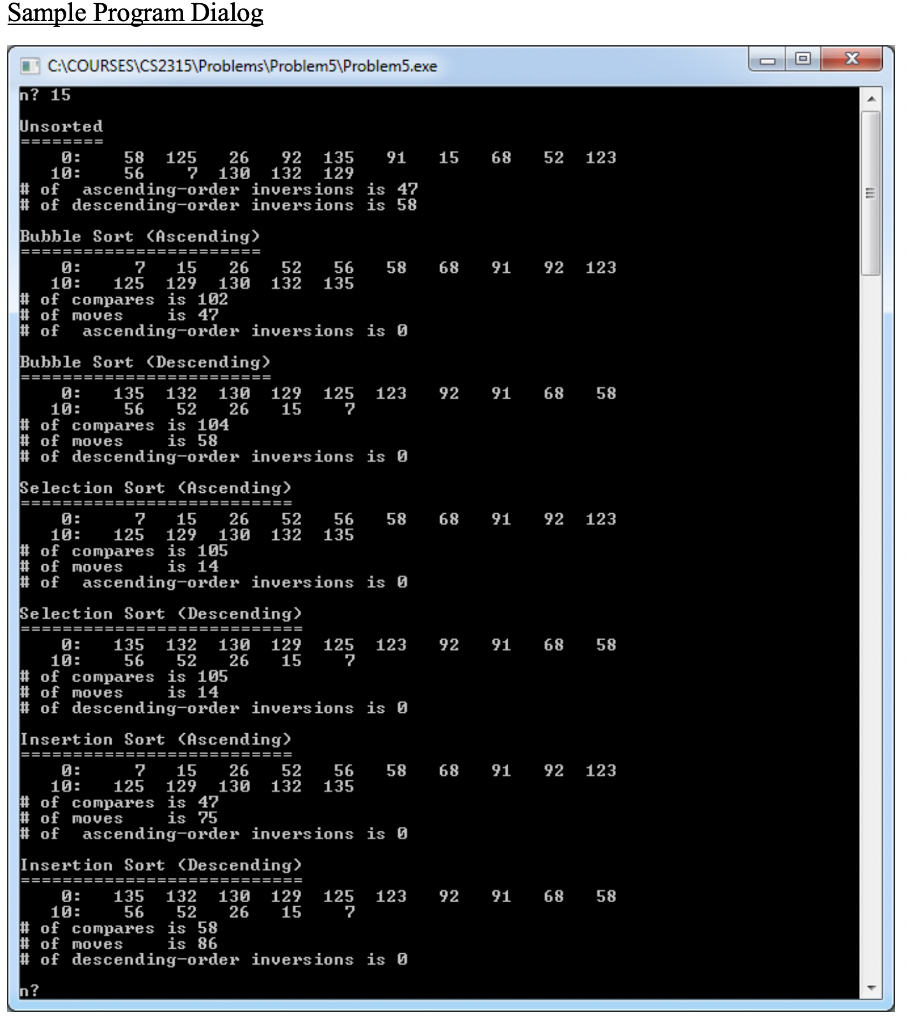Question
C Programming Take screenshot of compiled output once complete. (which should look similar to the sample one provided). Fill in the missing code in the
C Programming
Take screenshot of compiled output once complete. (which should look similar to the sample one provided).
Fill in the missing code in the four areas that say "Student provides missing code..."
All source files Problem5.c, Random.h, Random.c located below.
Please make sure to provide all completed source code and screenshot of compiled output.
-will rate positively.



//--------------------------------------------------
// Problem #5
// Problem5.c
//--------------------------------------------------
#include
#include
#include
#include
#include "..\Random.h"
//--------------------------------------------------
int main()
//--------------------------------------------------
{
void BuildRandomArray(int A[],const int n);
void CopyArray(int copyA[],const int A[],const int n);
void DisplayArraySlice(const char label[],const int A[],const int n,const int L,const int R);
int NumberOfInversions(const int A[],const int n,bool (*AreInverted)(const int LHS,const int RHS));
void DoBubbleSort(int A[],const int n,
bool (*ShouldSwap)(const int LHS,const int RHS),
int *numberCompares,
int *numberMoves);
void DoSelectionSort(int *A,const int n,
bool (*ShouldSelect)(const int LHS,const int RHS),
int *numberCompares,
int *numberMoves);
void DoInsertionSort(int *A,const int n,
bool (*ShouldInsert)(const int LHS,const int RHS),
int *numberCompares,
int *numberMoves);
bool Ascending(const int LHS,const int RHS);
bool Descending(const int LHS,const int RHS);
int n;
SetRandomSeed();
printf("n? ");
while ( scanf("%d",&n) != EOF )
{
int *A = (int *) malloc(sizeof(int)*n);
int *copyA = (int *) malloc(sizeof(int)*n);
int numberCompares;
int numberMoves;
BuildRandomArray(A,n);
DisplayArraySlice("Unsorted",A,n,0,n-1);
printf("# of ascending-order inversions is %d ",
NumberOfInversions(A,n,Ascending));
printf("# of descending-order inversions is %d ",
NumberOfInversions(A,n,Descending));
CopyArray(copyA,A,n);
DoBubbleSort(copyA,n,Ascending,&numberCompares,&numberMoves);
DisplayArraySlice("Bubble Sort (Ascending)",copyA,n,0,n-1);
printf("# of compares is %d ",numberCompares);
printf("# of moves is %d ",numberMoves);
printf("# of ascending-order inversions is %d ",
NumberOfInversions(copyA,n,Ascending));
CopyArray(copyA,A,n);
DoBubbleSort(copyA,n,Descending,&numberCompares,&numberMoves);
DisplayArraySlice("Bubble Sort (Descending)",copyA,n,0,n-1);
printf("# of compares is %d ",numberCompares);
printf("# of moves is %d ",numberMoves);
printf("# of descending-order inversions is %d ",
NumberOfInversions(copyA,n,Descending));
CopyArray(copyA,A,n);
DoSelectionSort(copyA,n,Ascending,&numberCompares,&numberMoves);
DisplayArraySlice("Selection Sort (Ascending)",copyA,n,0,n-1);
printf("# of compares is %d ",numberCompares);
printf("# of moves is %d ",numberMoves);
printf("# of ascending-order inversions is %d ",
NumberOfInversions(copyA,n,Ascending));
CopyArray(copyA,A,n);
DoSelectionSort(copyA,n,Descending,&numberCompares,&numberMoves);
DisplayArraySlice("Selection Sort (Descending)",copyA,n,0,n-1);
printf("# of compares is %d ",numberCompares);
printf("# of moves is %d ",numberMoves);
printf("# of descending-order inversions is %d ",
NumberOfInversions(copyA,n,Descending));
CopyArray(copyA,A,n);
DoInsertionSort(copyA,n,Ascending,&numberCompares,&numberMoves);
DisplayArraySlice("Insertion Sort (Ascending)",copyA,n,0,n-1);
printf("# of compares is %d ",numberCompares);
printf("# of moves is %d ",numberMoves);
printf("# of ascending-order inversions is %d ",
NumberOfInversions(copyA,n,Ascending));
CopyArray(copyA,A,n);
DoInsertionSort(copyA,n,Descending,&numberCompares,&numberMoves);
DisplayArraySlice("Insertion Sort (Descending)",copyA,n,0,n-1);
printf("# of compares is %d ",numberCompares);
printf("# of moves is %d ",numberMoves);
printf("# of descending-order inversions is %d ",
NumberOfInversions(copyA,n,Descending));
free(A);
free(copyA);
printf(" n? ");
}
system("PAUSE");
return( 0 );
}
//--------------------------------------------------
void BuildRandomArray(int A[],const int n)
//--------------------------------------------------
{
int i;
for (i = 0; i
A[i] = RandomInteger(1,10*n);
}
//--------------------------------------------------
void CopyArray(int copyA[],const int A[],const int n)
//--------------------------------------------------
{
int i;
// for (i = 0; i
i = 0;
TOL1:
if ( !(i
{
copyA[i] = A[i];
i++;
goto TOL1;
}
BOL1:
; // Do nothing
}
//--------------------------------------------------
void DisplayArraySlice(const char label[],const int A[],const int n,const int L,const int R)
//--------------------------------------------------
{
Student provides missing code to display A[i], i [ L,R ], 10 elements per line.
See the Sample Program Dialog for detailed formatting requirements. You are allowed to
use "real" loop control cJnstructs.
}
//--------------------------------------------------
int NumberOfInversions(const int A[],const int n,bool (*AreInverted)(const int LHS,const int RHS))
//--------------------------------------------------
{
int i,j,r;
for (i = 0,r = 0; i
for (j = i+1; j
if ( AreInverted(A[i],A[j]) ) r++;
return( r );
}
//--------------------------------------------------
bool Ascending(const int LHS,const int RHS)
//--------------------------------------------------
{
return( (LHS > RHS) ? true : false );
}
//--------------------------------------------------
bool Descending(const int LHS,const int RHS)
//--------------------------------------------------
{
return( LHS
}
//--------------------------------------------------
void DoBubbleSort(int A[],const int n,
bool (*ShouldSwap)(const int LHS,const int RHS),
int *numberCompares,
int *numberMoves)
//--------------------------------------------------
{
Student provides missing code to Bubble Sort the n elements in the array A
(A[i], i [ 0,n-1 ]) using the function-pointer parameter ShouldSwap()
to determine whether adjacent elements should be swapped. Count the
number of comparisons, *numberCompares, and the number of moves, *numberMoves,
needed to sort the n elements. The non-goto version of the Bubble Sort
(taken from page 101 of our text book)is given below.
int i,pass;
bool swapMade;
pass = 1;
*numberCompares = 0;
*numberMoves = 0;
do
{
swapMade = false;
for (i = 0; i
{
*numberCompares += 1;
if ( ShouldSwap(A[i],A[i+1]) )
{
int T = A[i]; A[i] = A[i+1]; A[i+1] = T;
*numberMoves += 3;
swapMade = true;
}
}
pass++;
} while ( swapMade );
}
//--------------------------------------------------
void DoSelectionSort(int *A,const int n,
bool (*ShouldSelect)(const int LHS,const int RHS),
int *numberCompares,
int *numberMoves)
//--------------------------------------------------
{
Student provides missing code to Selection Sort the n elements in the array A
(A[i], i [ 0,n-1 ]) using the function-pointer parameter ShouldSelect()
to determine whether an element should be selected. Count the
number of comparisons, *numberCompares, and the number of swaps, *numberMoves,
needed to sort the n elements. The non-goto version of the Selection Sort
(taken from page 99 of our text book) is given below.
int i;
*numberCompares = 0;
*numberMoves = 0;
for (i = 0; i
{
int T,j,select = i;
for (j = i+1; j
{
if ( (*ShouldSelect)(A[select],A[j]) ) select = j;
*numberCompares += 1;
}
T = A[i]; A[i] = A[select]; A[select] = T;
++*numberMoves, *numberMoves += 1, (*numberMoves)++;
}
}
//--------------------------------------------------
void DoInsertionSort(int A[1],const int n,
bool (*ShouldInsert)(const int LHS,const int RHS),
int *numberCompares,
int *numberMoves)
//--------------------------------------------------
{
Student provides missing code to Insertion Sort the n elements in the array A
(A[i], i [ 0,n-1 ]) using the function-pointer parameter ShouldInsert()
to determine when/where an element should be inserted. Count the
number of comparisons, *numberCompares, and the number of moves, *numberMoves,
needed to sort the n elements. The non-goto version of the Insertion Sort
(taken from page 134 of our text book) is given below.
int i;
*numberCompares = 0;
*numberMoves = 0;
for (i = 1; i
{
int v = A[i];
int j = i-1;
*numberMoves += 1;
while ( (j >= 0) && (*ShouldInsert)(A[j],v) )
{
*numberCompares += 1;
A[j+1] = A[j];
*numberMoves += 1;
j--;
}
A[j+1] = v;
*numberMoves += 1;
}
}
//--------------------------------------------------
// Random.h
//--------------------------------------------------
#ifndef RANDOM_H
#define RANDOM_H
#include
// initialize the "seed" used by the "rand()" function in
void SetRandomSeed(void);
// return uniformly, randomly chosen integer from [ LB,UB ]
int RandomInteger(int LB,int UB);
// return uniformly, randomly real number chosen from [ 0.0,1.0 )
double RandomReal(void);
// return randomly-chosen boolean with bias from { false,true }
bool RandomBoolean(double bias);
// return uniformly, randomly-chosen character from characters[i], i in [ 0,(size-1) ]
char RandomCharacter(char characters[],int size);
#endif
//--------------------------------------------------
// Random.c
//--------------------------------------------------
#include
#include
#include
#include
#include ".\Random.h"
//--------------------------------------------------
void SetRandomSeed(void)
//--------------------------------------------------
{
srand(time(NULL));
}
//--------------------------------------------------
int RandomInteger(int LB,int UB)
//--------------------------------------------------
{
return( (int) (RandomReal()*(UB-LB+1)) + LB );
}
//--------------------------------------------------
double RandomReal()
//--------------------------------------------------
{
int R;
do
R = rand();
while ( R == RAND_MAX );
return( (double) R/RAND_MAX );
}
//--------------------------------------------------
bool RandomBoolean(double bias)
//--------------------------------------------------
{
return( RandomReal()
}
//--------------------------------------------------
char RandomCharacter(char characters[],int size)
//--------------------------------------------------
{
return( characters[RandomInteger(0,(size-1))] );
}
Step by Step Solution
There are 3 Steps involved in it
Step: 1

Get Instant Access to Expert-Tailored Solutions
See step-by-step solutions with expert insights and AI powered tools for academic success
Step: 2

Step: 3

Ace Your Homework with AI
Get the answers you need in no time with our AI-driven, step-by-step assistance
Get Started


